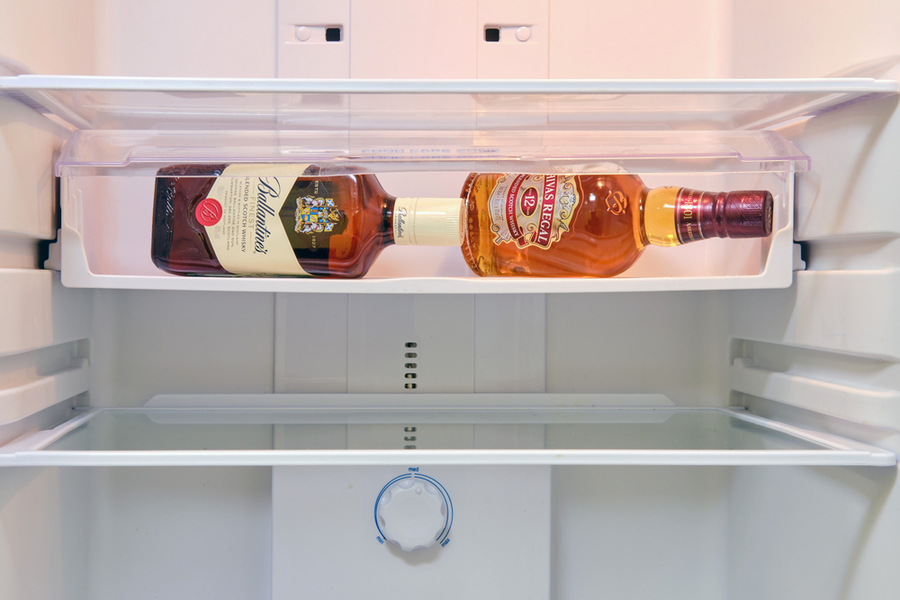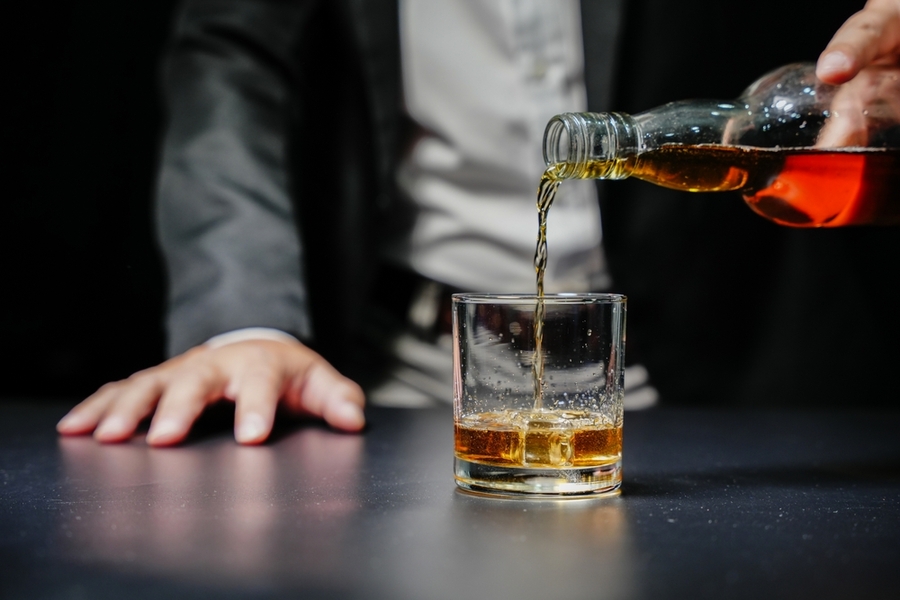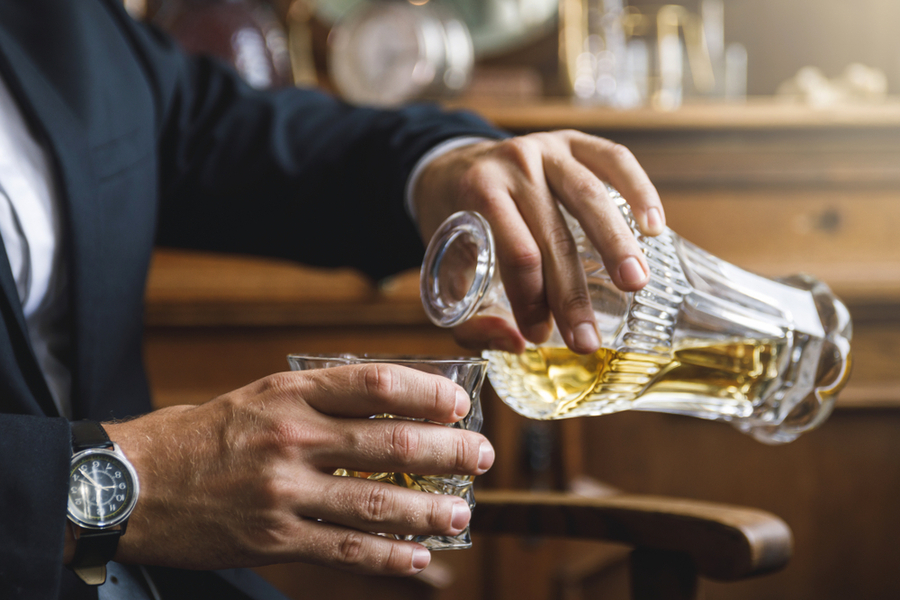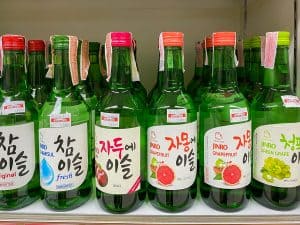
Distillers and blenders produce whiskey with the belief that someone will enjoy it someday in the future. While enjoying a good whiskey is a beautiful way to relax or share stories with friends and loved ones, storing your whiskey should also be one of your priorities.
Luckily, keeping whiskey isn’t as involved as storing wine; there are still a few ground rules you should follow to ensure your whiskey is stored correctly.
In essence, there are a few steps you’d need to take to ensure your whiskey always tastes great:
- Avoid sunlight and other bright sources of light
- Keep the temperature between 59ºF and 68ºF (15–20ºC)
- Never refrigerate or even freeze whiskey
- Always store the bottles upright
- Decant leftover whiskey into smaller bottles to minimize oxidation
- Insure your collection if you have rare and expensive bottles.
We’ve collected the best tips and ways to store your whiskey to ensure it stays in the best condition for enjoyment in the years to come. Let’s dive in and help you store your whiskey like a pro.
How To Store Your Whiskey Like a Pro

Let’s look at ways you can store your whiskey without compromising its flavor and smell. Whether you’re investing in expensive bottles or buying whiskey for mixing cocktails or sipping at home, it is crucial to store your whiskey correctly.
We’ve collected the best tips to help your whiskey stay in the best possible shape so you can enjoy it whenever you feel like a dram.
Avoid Sunlight

Perhaps the most crucial rule for storing whiskey is avoiding direct sunlight and intense light—this is whiskey’s worst enemy by far.
The sun’s UV rays will fade the label, break it down, and dry out the cork (if a cork stopper is used instead of a screw cap).
We know appearance matters when it comes to whiskey, and the sun’s UV rays will break down the flavor compounds, the aroma will dull, and the color will start to fade.
Tips to avoid sunlight:
- Keep your whiskey in the dark cabinet away from heat sources (we’ll look at the impact of heat later).
- Whenever possible, store your whiskey in the original container, box, or tin it came in—this will help to preserve your whiskey’s taste, aroma, and color.
- If you want to go the extra mile, consider this: store bottles in mailing tubes like these. A four-twelve-inch tube will hold almost any bottle and protect it from direct sunlight. Wrap your bottles in honeycomb paper before placing bottles inside the tubes to protect labels and glass. This is an excellent way to protect your bottles.
- If you feel creative, download a picture of your whiskey and stick it on the outside of the tube, so you know what’s inside without disturbing your stash or frantically searching for that bottle you received as a gift and want to impress the gifter with a tipple.
Keep the Temperature Constant
Tying in with avoiding sunlight and intense light is temperature.
While storing your whiskey outside in a root cellar (if you have one) might not be the most convenient option, it certainly is an excellent way of storing whiskey.
If you’re not lucky enough to have a root cellar, a basement, or a cellar, a cupboard inside the house away from heat sources will also suffice.
Avoiding temperature fluctuations and direct light is necessary to keep your whiskey in top shape. According to experts, you should store whiskey between 59ºF and 68ºF (15–20ºC).
Never Freeze Whiskey

As tempting as it may be to let the bottle of whiskey join the vodka in the freezer, resist the temptation, and don’t do it.
It may not damage the whiskey, but it will considerably be duller —click here to see what happens if you decide to refrigerate it. If you want chilled whiskey, use an ice ball or whiskey stone to chill your whiskey in the glass.
Upright Is the Right Way
As an upright citizen, you must also store whiskey upright.
Wine is stored horizontally to keep the cork moist, but whisky should always be stored upright to keep moisture away from the cork or cap. The high proof of whiskey will deteriorate if it’s in constant contact with the cork.
Cardboard tubes are an excellent way to ensure your whiskey stays organized and upright.
Remember to tilt the bottles horizontally a few times a year to moisten the cork. Let the whiskey soak the cork for one or two minutes and return the bottles to their upright position. Doing this will keep the cork moist and ‘fresh’ and inhibit oxidation.
Think Before You Open

Once you’ve opened a bottle, remember it is best to consume it within two months because the flavor compounds will start to dull and change due to oxidation.
Calculate your consumption so you know how many bottles you can open at a time and safely drink before it loses its flavor.
Decant Your Whiskey

When you open a bottle, the air inside has more space to interact with your whiskey and oxidize it.
If you cannot consume a bottle within two months, decant the rest of the whiskey into (sterile) smaller bottles—this will minimize exposure to air and the dreaded oxidation.
Some guiding timelines:
- More than two-thirds: your whiskey should last for another year.
- Half full: you can expect your whiskey to last between four and six months
- Less than half: your whiskey might survive three or four months before losing its original flavor, but after a month, you can expect the taste to start changing already due to oxidation.
Another way of storing an opened bottle of whiskey is to pop some sterilized glass marbles into the bottle. This will raise the level inside the bottle and minimize the amount of air that can come into contact with your whiskey.
Be careful when pouring so you don’t end up with marbles in your glass!
Insure Your Collection

Rare whiskies are known to reach sky-high prices at auction, and an investment like that should be protected and insured. Speak to your insurance broker to set up a policy to protect your rare and expensive bottles against catastrophe or theft.
To illustrate why you should take out an insurance policy for your rare and expensive bottles: one bottle of Macallan Fine and Rare 60-year-old whiskey from 1926 sold at auction for a whopping $1.9 million, and in 2018 a bottle from the same batch sold for $1.2 million.
As you can see, protecting your investment from disaster and theft is essential, but so is keeping your bottles—contents and exterior—in pristine condition.
Remember, investing in rare and beautiful whiskies should also be fun—you cannot drink bonds, cryptocurrencies, or stock—but you can drink whiskey!
Leave the rare bottles (we’re looking at you with longing Pappy van Winkle 23-year-old) alone, but sample some of your other expensive whiskies.
If you’re in a position to purchase expensive whiskies, try to buy them in pairs—one for the investment and one to enjoy.
We understand that not everyone can afford this, but if you can, you won’t have to wonder what that expensive bottle you’ve been holding on to tastes like.
Conclusion
Thankfully storing whiskey isn’t as involved or tricky as storing wine. However, correctly storing your whiskey will help you preserve your whiskey taste and appearance.
Following our tips will help you keep whiskey properly, and you’ll never have to worry about spoiling a good bottle of whiskey again.









